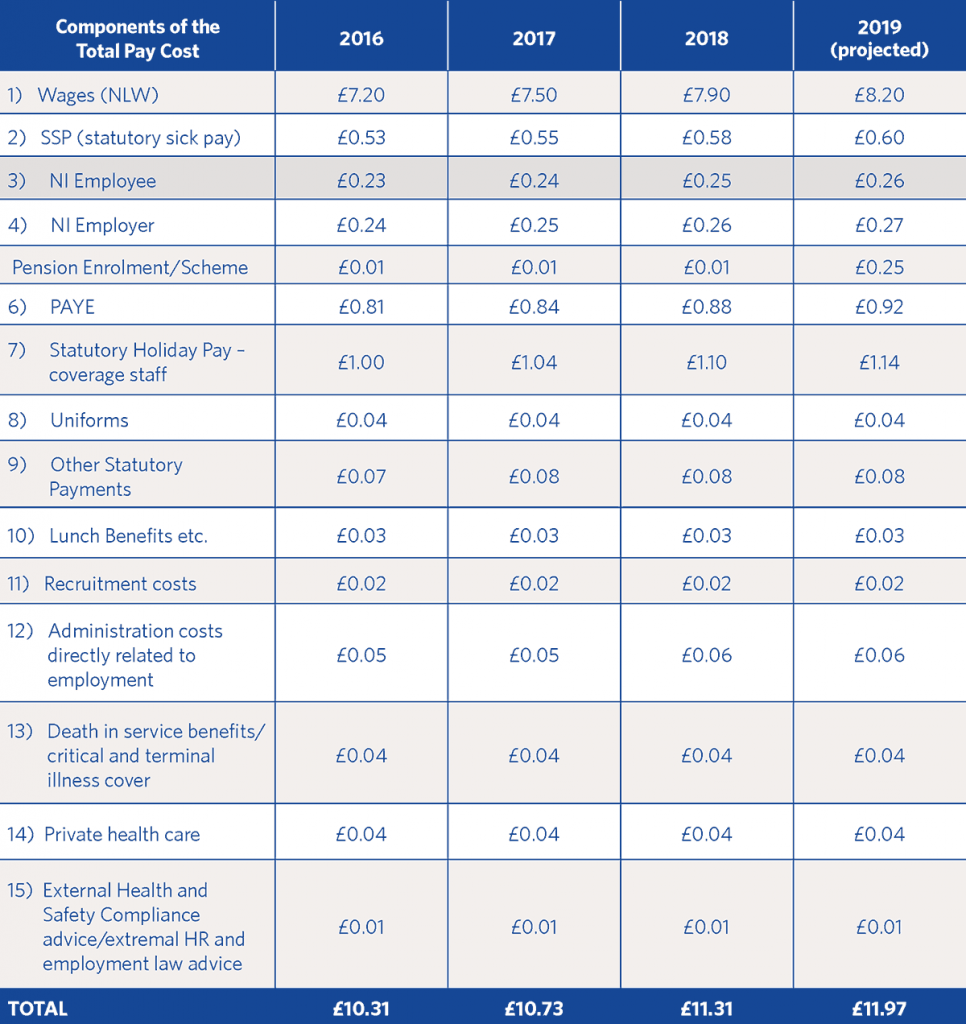A study by the University of Stirling in collaboration with the SGF has discovered that the true cost to retailers of the National Living Wage is far higher than the £8.21 headline figure.
by Antony Begley
No matter which way you look at it, employing staff in the local retailing industry is expensive. The long opening hours of the typical convenience store make staffing such a significant cost for all retailers. Even small stores have to cover a minimum of around 200 paid hours per week with many larger and busier stores looking at two or three times more than that.
When the Low Pay Commission was established in 1998 and the first ever National Minimum Wage was introduced the following year, many in the industry suspected that there was going to be trouble ahead.
While very few employers in the retail industry have a problem with the concept of staff being paid a decent wage, the fact that the minimum wage has risen significantly and consistently every year without fail does cause a problem.
It’s unlikely there is a single retailer out there whose turnover and profits have increased every year without fail during the same time period. In fact, as most retailers will be all too well aware, local retailing has arguably never been tougher.
Consider that when the minimum wage was first introduced in 1999 the hourly rate was £3.60. That was less than 20 years ago. The National Living Wage is currently £7.83 for those 25 and over; in other words it has more than doubled in that time.
There are of course strong arguments that the minimum wage had to rise significantly to catch up after years of miserly wage rates – but more than doubling in under two decades? There is not a retailer in Scotland, large or small, that does not view wage rates as a significant stress on their business. Indeed, there are many who see a steadily increasing minimum wage as a credible threat to the sustainability of their business.
What is equally concerning is the fact that the continued growth of the minimum wage is unlikely to slow in the future. The National Living Wage for next year (for those aged 25 and over) is set to be hiked again to £8.21. Bear in mind that 79% of staff in convenience stores are in the over-24-year-old age range, according the Scottish Local Shop Report 2018. Over half a million workers will be affected.
But that’s not the end of the story.
A new paper published by the University of Stirling in association with the Scottish Grocers’ Federation (SGF), reveals that the ‘real’ cost of the living wage to retailers is in reality significantly higher than the baseline £8.21 figure.
In depth analysis carried out by the university has concluded that the true cost of the living wage to retailers is in fact £11.97 an hour.
This figure is calculated by including the addition of the various associated ‘on-costs’ of employment such as National Insurance, PAYE, sick pay, pension, recruitment costs and so on.
Leigh Sparkes, Professor of Retail Studies at the Institute of Retail Studies at the University of Stirling, and author of the paper, suggests that the very future of the local retailing sector is under threat at least partly because of spiralling employment costs.
He comments: “Our analysis shows that a rate of £8.21 for the employee is transformed into £11.97 true employee costs for the retailer. The 30p increase in the base rate for April 2019 results in a 67p increase for retailers. In other words, the increase in the retailer cost is double that of the employee cost.”
Sparkes is very clear about the potential effect of constant, unchecked growth in the Living Wage: “Staff are one of the most crucial resources in any retail business but retailing as a sector is undergoing massive change and the pressures on local and independent retailers are immense. The ability to compete and to respond to changing consumers is dependent on an ability to invest and to make a living return for retailers. Sustainable local, independent, convenience retailing is under threat.”
While he accepts that “it is very difficult for retailers to argue against a Living Wage for their employees” as they “want to feel that they are good, sustainable employers and that employees are valued parts of the business”, he does highlight that employee pay is another cost pressure on retailers, at a time when they are facing increasing costs across the board.
The Apprenticeship Levy, business rates, rents, the Deposit Return Scheme, auto-enrolment of pensions and more are driving the costs of business up steadily and steeply.
Edinburgh Premier retailer Dennis Williams is similarly understanding of the need to pay a decent wage but is calling on the Low Pay Commission to take decisions on increasing the rate within a wider context.
He told SLR: “The national living wage is a massive strain on our sector just now. The extra cost for our own business from the first of April has already been around £5,000. That is a lot of money. I’m all for giving someone a reasonable wage. I have no issue with that at all, but we need decisions to be made with an appreciation of the bigger picture and the commercial realities.”
Williams stresses that the minimum wage is benefitting some but many others are losing out. “If you look at the facts and figures, staff hours are getting cut back across our industry, people are not getting replaced and people who own businesses are needing to work longer hours,” he says.
The figures he quotes come from a joint submission to the Low Pay Commission earlier this year by the SGF and the Association of Convenience Stores which cited a study of 3,000 independent retailers. The study found that 75% of retailers had reduced staff hours, 60% had worked more hours themselves to cover staff shortages and 39% have had to let staff go. Not exactly the outcome the Low Pay Commission had hoped for, presumably.
Williams broadens the argument out by suggesting that this myopic approach belies a lack of recognition of the huge value that the local retailing sector brings to the Scottish economy. Local retailing outlets across the country provide regular employment for over 40,000 people at a time when stability is being eroded in many other industries.
SGF Chief Executive Pete Cheema echoed these concerns: “Rises in the National Living Wage are part of a bigger picture of constantly increasing costs for retailers. In Scotland the tax burden has increased by almost 30% since 2008.
“This latest paper reveals the real cost of employment and, at almost £12 an hour, it’s clear that many retail businesses will be unable to absorb that cost increase without making savings elsewhere. The Low Pay Commission must take the increasing tax burden, the increasing cost of doing business and the true cost of employment into account and be extremely cautious with any further rate rises in the National Living Wage.”
The final word must go to Leigh Sparkes who offers a blunt and stark conclusion in his paper: “If we want a sustainable local, independent convenience store sector that is a true part of local communities then the costs faced by these retailers, and their limited scope for action, need to be understood, recognised and ameliorated.”







